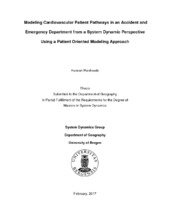Modeling Cardiovascular Patient Pathways in an Accident and Emergency Department from a System Dynamic Perspective Using a Patient Oriented Modeling Approach
Master thesis

View/
Date
2017-04-07Metadata
Show full item recordCollections
- Department of Geography [676]
Abstract
This thesis provides a detailed overview of a system dynamics model that focuses on the accident and emergency department and the clinical pathways of cardiovascular patients at Haukeland University hospital. A patient-oriented approach was chosen and sub-models representing patient attributes and accident and emergency resources were developed based on this approach. The simulation model illustrates accident and emergency processes and patient attributes in a disaggregated system. In addition to System Dynamics, other modeling concepts facilitated the modeling process. This included object-based and discrete event modeling concepts where object-based modeling concepts were used to create interactive objects, and stock and flow structures were constructed to be discrete in time and space. As such, the model is considered a hybrid model. The model serves as a network of resources aiding the patient in the most appropriate direction in order to place him or her in the right location at the right time. The patient-oriented modeling approach has proven useful, as it has enabled a systematic observation on the emergence of various cardiovascular pathways based on patient attributes incorporated in the model. The use of objects to represent attributes and AED processes make this model a unique take on System Dynamics. The attributes arising from the model were built on predetermined values in the form of graphical functions, enabling scenario testing to capture the resources the patient claimed in the AED. To this end, a successful simulation model has been created that permits a detailed observation of clinical pathways for cardiovascular patients.